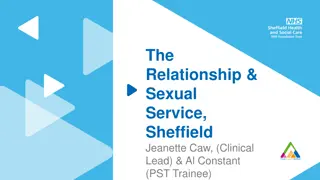Sheffield Support Grid and Localities Model Update
Localities in Sheffield have implemented structures to ensure students are placed on the Sheffield Support Grid (SSG), with moderation done at various levels. Challenges in the new working methods include pace of the program and aligning the workforce. Moving forward, localities plan to strengthen collaborations, offer support, and manage high-needs funding allocations effectively.
Uploaded on Sep 14, 2024 | 1 Views
Download Presentation

Please find below an Image/Link to download the presentation.
The content on the website is provided AS IS for your information and personal use only. It may not be sold, licensed, or shared on other websites without obtaining consent from the author. Download presentation by click this link. If you encounter any issues during the download, it is possible that the publisher has removed the file from their server.
E N D
Presentation Transcript
Locality Model- update All 7 localities have a structure in place to ensure pupils have been placed on the Sheffield Support Grid (SSG)and moderation has taken place at a FoS s and/or locality level. A city wide moderation meeting has taken place to ensure we have consistency in the application of the Sheffield Support Grid. A Family of Schools (FoS) model is being adopted by the majority of localities, particularly around the SENCO role.
Localities Model update Localities are looking at how they use their top up funding, how it has the greatest impact and supports schools to continue to develop inclusive practice and provision. Two keys models of how this could be used are emerging, most localities they are opting for a hybrid of the two. The first is to look at how the money is used to support individual learners. The second looks at building capacity and skills across the locality workforce, including the continued professional development of the SENCO role.
Challenges The new ways of working are seen by all localities as a real opportunity to support some of the most vulnerable learners however there continues to be a number of challenges, including: The pace of the programme Understanding roles, responsibilities and functions, including what continues to be the Local Authorities statutory functions. Complexities of collaborative working Training and development of locality workforce The aligning of the LA workforce with the locality model Concerns about the capacity within localities to deliver some functions in particular the Agree to Assess process. Ensuring the sustainability of the model, particularly once the 50k up front funding is no longer available.
Localities going forward Cross sector moderation of the Sheffield Support Grid, including the Specialist sector. Strengthening the work with the MAST Early Help pilots. Continue to offer support from the LA to share good practice and also manage pressure points in the system.
Localities funding April-August high needs funding allocations (based on the January 2016 Census data) have been communicated to localities The city-wide moderation exercise demonstrated over 70% consistency in use of the Support Grid; some minor further moderation checks will take place By the end of term, localities will provide the Council with the total numbers of pupils confirmed as level 3, 4 or 5 on the Support Grid As planned, these numbers will determine the September March high needs funding allocation to localities If Grid numbers lead to a significant negative impact on locality allocations, discussions about options will be held with localities and the School Forum before any final allocations are made.























